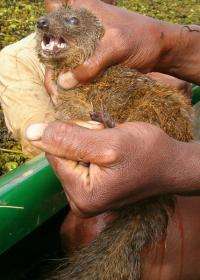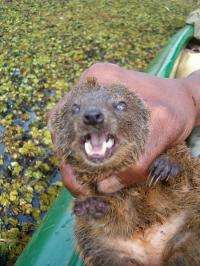New carnivorous mammal discovered in Madagascar - first in 24 years

(PhysOrg.com) -- A new species of small carnivore, known as Durrell’s vontsira (Salanoia durrelli) has been identified by researchers from the Durrell Wildlife Conservation Trust, the Natural History Museum, London, Nature Heritage, Jersey, and Conservation International (CI). The small, cat-sized, speckled brown carnivore from the marshes of the Lac Alaotra wetlands in central eastern Madagascar weighs just over half a kilogramme and belongs to a family of carnivores only known from Madagascar. It is likely to be one of the most threatened carnivores in the world. The findings are outlined in the latest issue of the taxonomic journal Systematics and Biodiversity.
The carnivore was first seen swimming in a lake by researchers from the Durrell Wildlife Conservation Trust on a field trip surveying bamboo lemurs (Hapalemur griseus alaotrensis) in 2004. After briefly examining the animal, the team suspected they had witnessed a new species and so took photographs. By examining brown-tailed vontsira (Salanoia concolor) specimens in the Natural History Museum’s collections, Museum zoologists confirmed the animal was a new species. The brown-tailed vontsira is the closest relative of the new species, which zoologists named in honour of the conservationist and writer Gerald Durrell, who died 15 years ago.
Fidimalala Bruno Ralainasolo, a conservation biologist working for Durrell Wildlife Conservation Trust who originally captured the new carnivore, commented ‘We have known for some time that a carnivore lives in the Lac Alaotra marshes, but we’ve always assumed it was a brown-tailed vontsira that is also found in the eastern rainforests. However, differences in its skull, teeth, and paws have shown that this animal is clearly a different species with adaptations to life in an aquatic environment. It is a very exciting discovery and we decided to honour our founder, the world renowned conservationist Gerald Durrell, by naming this new species after him. However, the future of the species is very uncertain because the Lac Alaotra marshes are extremely threatened by agricultural expansion, burning and invasive plants and fish. It is a highly significant site for wildlife and the resources it provides people, and Durrell Wildlife Conservation Trust is working closely with local communities to ensure its sustainable use and to conserve Durrell’s vontsira and other important species.’
Paula Jenkins, Natural History Museum zoologist said, ‘We know very little about the small mongoose-like vontsiras because they are poorly known and rarely seen or studied in the field. This research is a fantastic example of the importance and relevance that Museum collections have for contemporary scientific research. Though people may know that museums such as the Natural History Museum hold reference collections, few people are aware how critical these collections are to our understanding of the world today.’

Stephan M Funk of Nature Heritage, formerly at Durrell Wildlife Conservation Trust and co-author of the paper, said ‘Population genetics and evolution of the Durrell’s vontsira and related species remain badly understood, highlighting the importance of future research. More important, however, is the protection of the wetlands around Lac Alaotra, which remain highly threatened.’
The habitat of Durrell’s vontsira has been suffering from a number of threats over the past decades, from introduced fish to silting and pollution from fertiliser and pesticides. While the conservation status of the new species remains to be formally evaluated, it is likely to be threatened as a result of small population size, restricted distribution and the impact of habitat degradation.
Remarkably, Lac Alaotra hit the headlines only a few months ago when the extinction of the Alaotra grebe (Tachybaptus rufolavatus) was announced. Now a new species has been described from the very area where the last Alaotra grebe was seen.
Frank Hawkins of Conservation International, co-author of the paper describing the species, said ‘This species is probably the carnivore with one of the smallest ranges in the world, and likely to be one of the most threatened. The Lac Alaotra wetlands are under considerable pressure, and only urgent conservation work to make this species a flagship for conservation will prevent its extinction.’
Provided by Conservation International

















